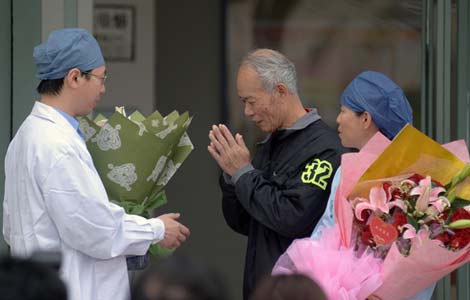Tombstones go digital
Updated: 2013-04-01 16:38
(Xinhua)
|
||||||||
SHENYANG - As Chinese prepare to mark Tomb-Sweeping Day, tech-savvy youngsters have brought a new digital perspective to this longstanding tradition of ancestor worship.
Many celebrating this national holiday from April 4-6 by paying their respects in graveyards may wonder what people are doing waving their smartphones over tombstones. The answer is that they are using two-dimensional quick response codes (QR codes) affixed to the monuments.
When scanned with modern digital gadgets, these small, square images allow mourners to access a virtual obituary where photos and video clips of the deceased can be found.
Cemeteries in Chinese cities including Shanghai, Shenyang and Fujian have seen a growing number of QR code stickers on headstones, right next to their engraved epitaphs.
Information provided by the codes, normally ranging from names and dates of birth and death, to life stories of the deceased, has made memorials more dynamic and interactive.
"With the cold text inscribed on the tombstone supplemented by live music and pictures, my memory of my grandmother can be refreshed," said a woman surnamed Wang who was applying for a QR code for her deceased grandmother in Shenyang. "That will extend her life," she added.
Wang said she was expecting more people, even strangers passing by the tomb, to learn of the "ordinary but precious" life of her grandmother, who was a teacher, with the help of the new technology.
In a country where people pay their respects to deceased family members by visiting and sweeping their tombs every spring, it has taken little time for the high-tech innovation to gain popularity.
A worker with Shengjing Cemetery in Shenyang told Xinhua that over a dozen QR code stickers have been put on tombstones since the cemetery started offering such services for free just over a month ago. Most of the applicants are aged between 35 and 45.
"We have been receiving inquiries. When more people know about the technology of QR codes, the service will definitely find a growing market," said Li Yinqi, an official at the cemetery.
The machine-readable barcode, invented in Japan in the early 1990s, is now widely used for product tracking, document management and marketing purposes.
The latest application of the code came as no great surprise in China, which has become familiar with cyber-mourning in recent years.
While older generations of Chinese would go to shrines and graves to remember dead relatives, modern urban Chinese are turning to virtual memorial halls. They light candles for their deceased family members and lay virtual wreaths in the online structures.
Chinese officials have been advocating the virtual drive out of concern over dwindling burial space, as well as air pollution and fire risks stemming from the tradition of burning paper "hell money" for the dead.
Although the number of tombstone barcode users is far smaller than that of people observing the tradition more conventionally, some have worried that modern technology will weaken China's entrenched culture of ancestor worship.
However, Yan Xuefei, an official with the Shenyang Municipal Civil Affairs Bureau, dismissed such criticism, arguing that the new tech better serves people's emotional needs.
"It does not matter how you worship your family members, realistically or virtually," he said. "What really matters is your feelings toward the deceased."

 Li Na on Time cover, makes influential 100 list
Li Na on Time cover, makes influential 100 list
 FBI releases photos of 2 Boston bombings suspects
FBI releases photos of 2 Boston bombings suspects
 World's wackiest hairstyles
World's wackiest hairstyles
 Sandstorms strike Northwest China
Sandstorms strike Northwest China
 Never-seen photos of Madonna on display
Never-seen photos of Madonna on display
 H7N9 outbreak linked to waterfowl migration
H7N9 outbreak linked to waterfowl migration
 Dozens feared dead in Texas plant blast
Dozens feared dead in Texas plant blast
 Venezuelan court rules out manual votes counting
Venezuelan court rules out manual votes counting
Most Viewed
Editor's Picks

|

|

|

|

|

|
Today's Top News
Boston bombing suspect reported cornered on boat
7.0-magnitude quake hits Sichuan
Cross-talk artist helps to spread the word
'Green' awareness levels drop in Beijing
Palace Museum spruces up
First couple on Time's list of most influential
H7N9 flu transmission studied
Trading channels 'need to broaden'
US Weekly

|

|







